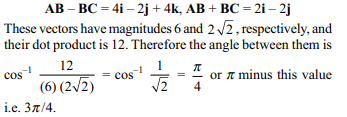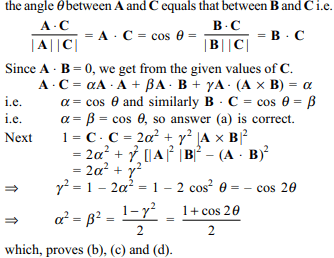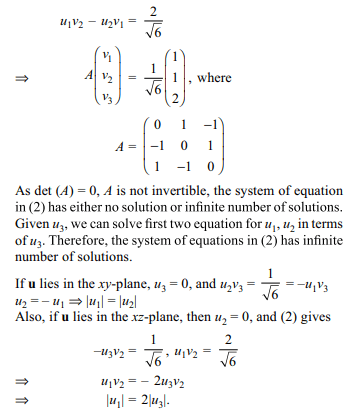1. Let a = 4i + 3j and b be two vectors
perpendicular to each other in xy-plane. The vectors c in
the same plane having projections 1 and 2 along a and c are
a) \[-\frac{2}{3}i+\frac{11}{2}j\]
b) 2i – j
c) \[-\frac{2}{5}i+\frac{11}{5}j\]
d) Both b and c
Explanation: Let b = xi + yj. Since a is perpendicular to b so

2. The vectors AB = 3i – 2j + 2k and
BC = – i – 2k are the adjacent sides of a parallelogram. The
angle between its diagonals is
a) \[\pi/4\]
b) \[\pi/3\]
c) \[3\pi/4\]
d) Both a and c
Explanation: The diagonals are given by

3. For non-coplanar vectors A, B and C,
|[A B C]| = | A| |B| |C| holds if and only if
a) A . B = B . C = C . A = 0
b) A . B = 0 = B . C
c) A . B = 0 = C . A
d) All of the Above
Explanation: Let \[\theta\] be the angle between A and B and \[\phi\] the

4. Let the unit vectors A and B be perpendicular
and the unit vector C be inclined at an angle \[\theta\] to both A and
B. If C = \[\alpha A + \beta B + \gamma (A \times B)\]
then
a) \[\alpha=\beta\]
b) \[\gamma^{2}=1-2\alpha^{2}\]
c) \[\gamma^{2}=-\cos2\theta\]
d) All of the Above
Explanation: We have |A| = |B| = |C| = 1. It is also given that

5. If a, b, c are three non-coplanar vectors
such that \[a + b + c = \alpha d\] and \[b + c + d = \beta a\] then a + b +
c +d is equal to
a) 0
b) \[\alpha a\]
c) \[\beta b\]
d) \[\left(\alpha+\beta\right)c\]
Explanation:


6. If a × b = 2i + 2j - k, a + b = i - 2j + 4k
then
a) \[a=\frac{1}{4}i+\frac{1}{4}j+k;b=\frac{3}{4}i-\frac{13}{4}j-5k\]
b) a = j + 2k; b = i - 4j - 6k
c) \[a=-\frac{1}{4}i+\frac{7}{4}j+2k;b=\frac{5}{4}i-\frac{19}{4}j-7k\]
d) All of the Above
Explanation:



7. Let \[u=u_{1}i+u_{2}j+u_{2}k\] be a unit vector in
\[R^{3}\] and \[w=\frac{1}{\sqrt{6}}\left(i+j+2k\right)\] . Given that there exists a vector
v in \[R^{3}\] such that \[\mid u\times v\mid =1\] and \[w.\left( u\times v\right) =1\] . Which of the
following statement(s) is(are) correct?
a) There is exactly one choice for such v
b) there are infinitely many choice for such v
c) If u lies in the xy-plane then \[\mid u_{1}\mid=\mid u_{2}\mid\]
d) Both b and c
Explanation:



8. The vector(s) which is/are coplanar with
vectors i + j + 2k and i + 2j + k, and perpendicular to the
vector i + j + k is/are
a) j – k
b) –i + j
c) – j + k
d) Both a and c
Explanation: A vector coplanar with i + j + 2k and i + 2j + k

9.Let x, y and z be three vectors each of
magnitude \[\sqrt{2}\] and the angle between each pair of them
is \[\frac{\pi}{3}\] . If a is a nonzero vector perpendicular to x and \[y\times z\] and b is a nonzero vector perpendicular to y and \[z\times x\] , then
a) b = (b.z) (z – x)
b) a = (a.y) (y – z)
c) a.b = – (a.y) (b.z)
d) Both b and c
Explanation: We can write a as a linear combination of y, z and y \[\times\] z. As a is orthogonal to y \[\times\] z, we can write



10. Let \[\triangle PQR\] be a triangle. Let a = QR, b =
RP and c = PQ and If |a| = 12, and b.c = 24 then which of
the following is (are) true?
a) \[\frac{\mid c\mid^{2} }{2}-\mid a \mid=12\]
b) a.b = –72
c) \[\mid a\times b+ c\times a \mid =48\sqrt{3}\]
d) All of the Above
Explanation:


